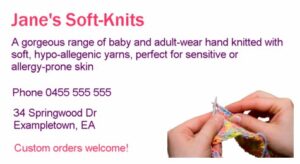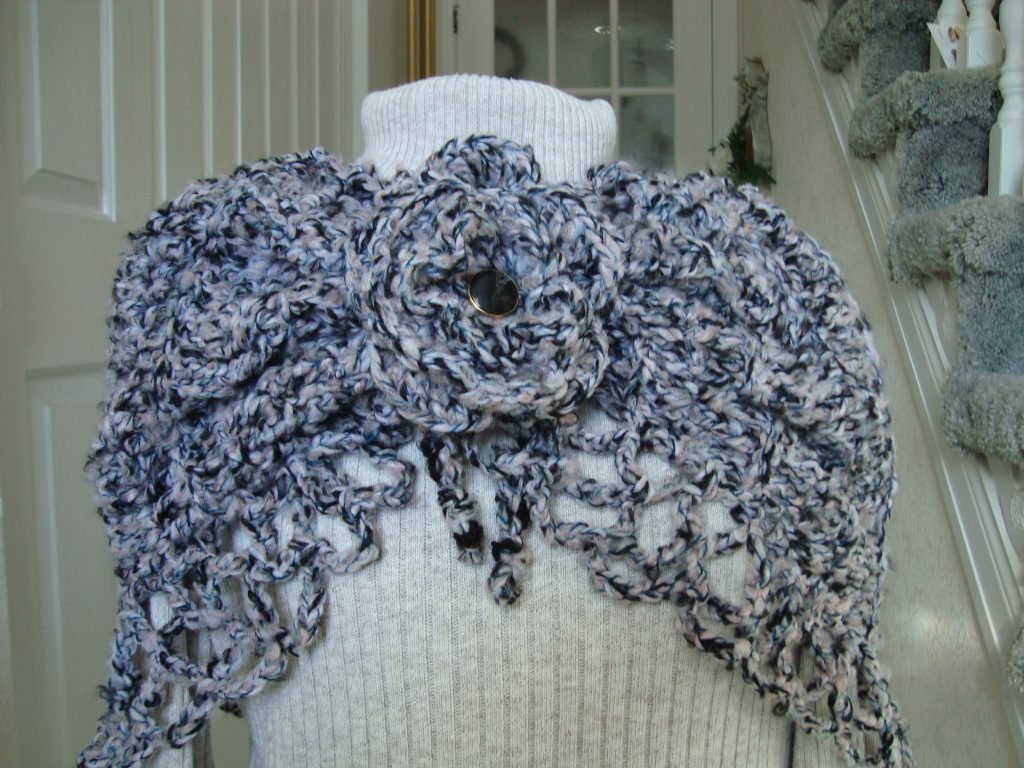Business cards are absolutely essential for knitting for profit, so how do you make sure they help you sell more of your knitting, and where's the best place to get them?
When you are knitting for profit, one of the most important things you'll need to do is get your name and knitting product range known to your customers. If you have been smart and chosen a niche market, you will have a very clear idea of who your customers are, where they are shopping, and what they are looking to buy.
Now you just need to find them and let them know that you have the solution to their needs and desires! One of the ways to do this is to make sure you have professional looking business cards that immediately tell people who you are, what you sell and who the knitted products are meant for.
Many knitters make the mistake of only putting their name and address on their knitting business cards – but that tells your customers nothing about how you can help them! When you design your card, you must make sure you include a clear description of your knitting product range or service, and how it will benefit your customer. For example:

If someone with sensitive skin sees Jane's card, they are much more likely to (a) keep the card, (b) call Jane for more information about her knitting range or (c) pass the card on to someone else they know who has sensitive skin or allergy problems.
Now this is just a quick mock-up I did on my computer…and realised afterwards that I left out Jane's last-name…we all make mistakes :), but the point is, even with seemingly important details like that missing, people would still be more likely to call Jane's knitting business from this card, than if she just had a plain old boring card with only her name and contact details on it.
Business cards are so important for getting free publicity for your knitting business. If you display at craft shows or markets they give customers (and potential customers) a way to contact you later. Every knitted item you sell should have a swing tag or business card attached, because people who have already bought from you are the people most likely to buy again, and they need to be able to find you.
So where do you get knitting business cards?
There are lots of online business card providers, but always remember – you get what you pay for! If the deal seems cheap, its probably because they are using cheap or thin card and low quality printing inks and processes. I have been burned by this – ordering what was described as “premium” business cards and getting undersized cards on thin paper that looked like I'd printed them myself on a home inkjet printer!
So if you use an online provider, check the SIZE of the cards (standard business cards are 89 x 51mm or 3.5 x 2 inches), the WEIGHT of the card they are printed on (should be at least 80lb stock, 350g/m2 or 12pt thickness or they will look and feel cheap) and the FINISH of the surface (the best, most popular finishes now are low-sheen or semi-gloss.
Some people still like high-gloss and matte finishes, but be aware that many people think these finishes make their cards look cheap). Also check postage costs as they can make seemingly cheap cards very expensive!
I have used ClickBusinessCards.com and been happy with the results. I live in Australia, so use the Australian branch, but they also have sites for the USA, UK and New Zealand. Like most card companies online, they have standard templates that you can modify yourself.
Try typing 'business cards' into your local google search and you'll find plenty of different sites. The other site I like is zazzle.com, which has some beautiful templates you can use for swing-tags.
The other option is to go to your local printer or graphic designer. This means you'll get much more personalised service, and is a good way to go if you are not confident designing yourself, or would like some advice about layouts and colours for a knitting business card. Just remember, on your knitting business cards you should include:
►Your Business name (if you have one)
►Your name (and title if you want, eg director, creator or owner)
►Your postal address
►Your phone number(s)
►Your email address
►Your web site or craft-mall address
►A description of your knitting products or services
►Their unique features
►How they will benefit your customer
This will help you get more customers, and make sure that your existing customers can buy from you again and again, helping you to make more money from your knitting!


You can also make the most of your business card by printing on both sides of it to further promote your products. This utilises the business card to the fullest extent without wasting advertising space.
“that looked like I’d printed them myself on a home inkjet printer!”
I don’t think there’s anything wrong with printing the cards on my home inkjet printer (which has a high enough resolution) – actually, I’m very happy about not having hundreds (or thousands) of cards laying around now that I know that I need to add some information 😉
But what I consider essential is good quality card stock – I used to use 224g/m2 drawing paper, then I got fed up with cutting it down do A4 and bought some exclusive high-quality card stock at a specialist office supplier. The paper is pricey but I only buy a packet at a time.
Hi Klara – I wasn’t meaning to suggest that home-printed cards are bad – as you mention, many home printers now have great resolution and can produce very good results (watch out for ink running if using as a hang-tag though). It was more that I expected a higher quality finish from a professional business card printer who was advertising their product as “premium” – so I did end up with a stack of cards I can’t use! 🙂
I used the printer at our local paper, and though they made beautiful cards, I made the mistake of not putting enough information on them. Lesson learned the hard way. I picked up another fiber artist/teacher’s card and it was printed on both sides listing absolutely everything she made, taught (and days & times) as well as her name and contact info. It was thin paper, but the info really got my attention.